This morning I happened across an auction on eBay for a mystery brand of C tenor saxophone. Unfortunately by the time I saw the auction listing, it was almost over.
Source: jaybasssax
This is how the seller describes this fascinating, and very rare horn:
This is probably a once-in-a-lifetime chance to own a VERY unusual historical tenor saxophone pitched in C from sometime in around 1900. It is not a C-melody (a common vintage saxophone in C which has a much narrower bore, more like an alto), nor is it a “high pitch” (A=458) Bb tenor, but an genuine example of the extremely rare tenor saxophone in C, pitched at approximately A=440. I have only found references of three other true large-bore C tenors in existence, two of which were made by Adolphe Sax during the 1800s.
This instrument is curious in many ways. The style of keywork is a transitional mixture of late 19th century and early 20th century, with an 1800s-style double octave key mechanism and Adolphe Sax-style keytouches and braces, but it also has a full 20th century keyrange from low Bb to high F, and early 20th-century-style trill keys as well. It bears no maker’s mark and no serial number – its previous owner theorized that it may have been made by Couesnon in France based on the style of the keywork and braces, and he estimated its date of manufacture as c. 1900.
This saxophone plays with a bold, vibrant, warm tone with a full-throated tenor saxophone sound that is unmistakably broader than a C-melody, and yet subtly lighter than a standard Bb tenor. The double-octave mechanism takes a little getting used to unless you’re already accustomed to playing 19th century saxophones and/or oboe, but works well. It responds very well for me using vintage/large chamber tenor saxophone mouthpieces, and I have performed several recitals on this instrument over the years. The high (palm key) E is a bit flat and takes some finesse, at least with my mouthpiece, but otherwise intonation is really quite good. It is a finely crafted instrument in good playable condition, although it hasn’t been worked on lately, so it could at least use shining up and possibly some additional tuneup for optimal performance.
Unlike a C-melody, this instrument feels more properly balanced on a neckstrap, more like a Bb tenor, and the sound is fuller and darker, more like a tenor and less like an alto compared to a C-melody. I made some rough measurements of this C tenor, and also comparison measurements of my early 1920’s Conn C-melody:
Length from bottom of bow to top of neck receiver tenon (with neck removed):
C tenor: 63 cm
C-melody: 63 cmLength from bottom of bow to top of bell:
C tenor: 38 cm
C-melody: 40 cmDiameter of outside of bore at top of neck receiver:
C tenor: 27 mm
C-melody: 26 mmDiameter of outside of bore at bottom of body tube (where it meets the bow):
C tenor: 55 mm
C-melody: 50 mmDiameter of outside of bore at top of low Bb tonehole:
C tenor: 70 mm
C-melody: 67 mmDiameter of widest part of bell:
C tenor: 131 mm
C-melody: 125 mm
I realize never did take the measurements of an Adolphe Edouard Sax C tenor saxophone belonging to a local man, but I still can, since it is at my tech’s shop getting restored. I should likely do that just for the sake of completeness.
That aside, here are the remainder of the photos of the very interesting, mystery C tenor saxophone currently for sale on eBay…
At the time of writing there are just under 2 hours left in the auction. The bids for this rare C tenor saxophone are to start at $1,095.00. So far there were no bids yet. ![]()
I must admit, I find this a bit surprising.

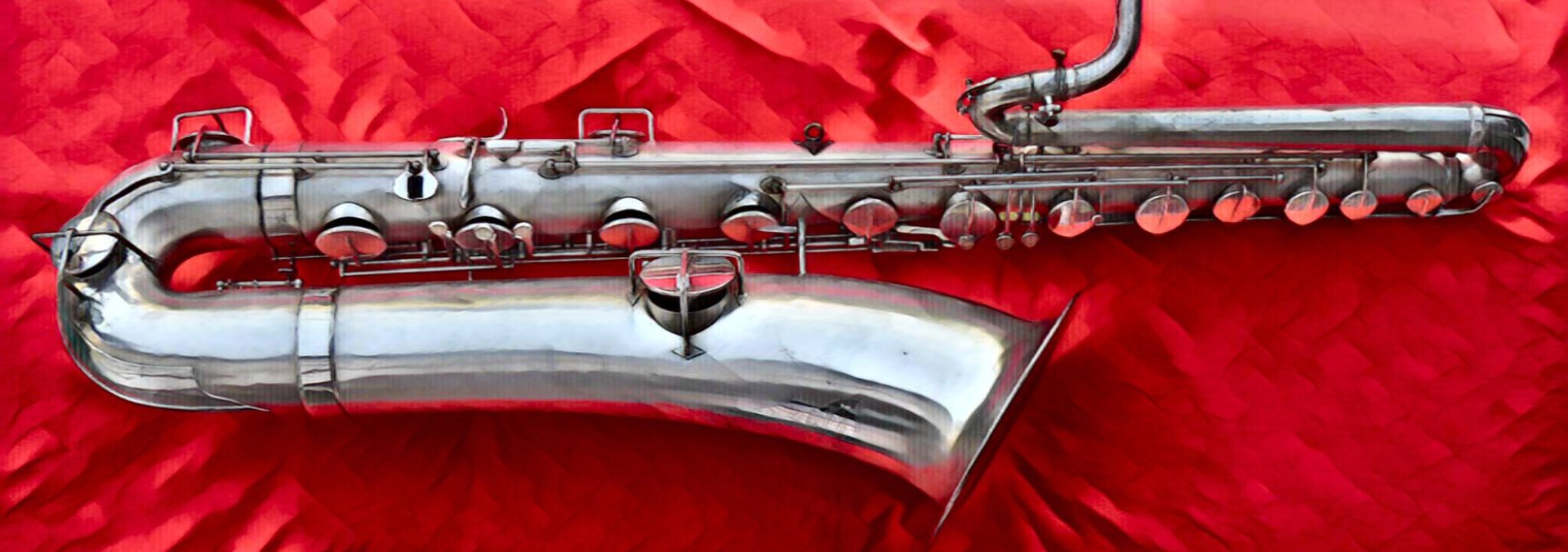

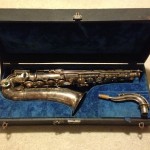

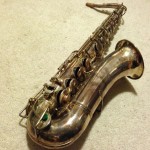


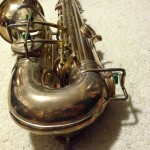
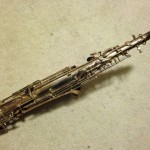
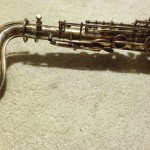


Update: After a whole bunch of re-lists, this poor, seemingly unwanted C-pitched tenor saxophone finally found a new home. However, it certainly didn’t sell for much.
At auction’s end it fetched only $560.00, with 3 bids. Sad, huh?
Speaking of pudding, whatever happened to pudding pops? I liked those.
Anyhow, I’ve made more than one comment about saxophone pitches and styles. Some people play, say, a Bb tenor as an over-grown Eb alto. Some people tend to draw out the various pitches’ tone color. I’ve heard and played C melody horns in such a way that they have a slightly more “reedy” and sweeter tone in comparison to a Bb tenor.
Of course, neither of the above approaches is “bad” or “incorrect,” I just prefer the latter. So, in this particular case, equating this horn with a Bb tenor only with a slightly different range really isn’t a good selling point for me.
It certainly does resemble a small tenor visually, rather than a C-mel. The bell doesn’t come up high and obscure the pinky cluster, the curve of the bell tips further forward in a more tenor-like fashion, and the neck is angled like a tenor rather than the typical “droop” of a C-mel.
Of course, the proof is in the pudding. The only way we’d know for sure if the instrument sounds different (and that’s what really matters, right?) is for someone to play it and one or more C-mels with the same setup.
The seller’s really cutting it fine, trying to make a distinction between a “C melody” and a “C tenor.” It’s really splitting hairs. Almost literally, based on those measurements.
Anyhow:
I doubt it’s an AE Sax instrument, based on the G#/C#/B/Bb cluster and style of the clothes guards. I also looked at the Lyrist, which is supposed to have been affiliated with AE Sax: again, it’s close but the the cluster and guards are different.
Couesnon had several different models available at the same time. I’ve got one example that looks pretty similar, but that model also has a range only to low B and has some interesting additional keywork. However, because Couesnon was so big and had so many stencils, they can’t be counted out just because I haven’t seen another that’s a closer match to this horn.
The horn I have in my pic collection that this resembles the most is the Edouard Robert (http://thesax.info/gallery3/index.php/Edouard-Robert/Eb-Alto-s-n-303-ca-1910-1922).
Of course, your mileage may vary :).